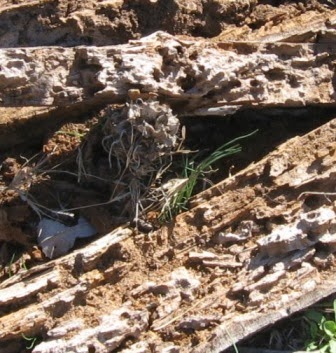 Took a short walk into the back field yesterday. Rainey came with me. She enjoys the walks down there. She had already been scouting for mice or rats in the upper field but had not come across one so she joined my little walk so she could do some exploring on her own. She doesn't let me get too far away before she starts calling out to me. Guess she just needs the reassurance that I haven't left her alone in the open.
Took a short walk into the back field yesterday. Rainey came with me. She enjoys the walks down there. She had already been scouting for mice or rats in the upper field but had not come across one so she joined my little walk so she could do some exploring on her own. She doesn't let me get too far away before she starts calling out to me. Guess she just needs the reassurance that I haven't left her alone in the open.
. The area she is walking in, is bare Barnett Shale, full of ancient sea shells when this area was the bottom of an ocean. There is plant life even there including a sandwort whose fresh, soft green leaves, harden to thorns as the summer heat on the bare ground kicks in. Those soft green leaves have not come out yet but you can see that start of green on the stems. They'll be in full bloom in May, like a little bouquet of white sandwort flowers on the ground and the plant is still soft to the touch. Not so when that heat kicks in after the bloom is over. No walking barefoot with these around.
I was searching for signs that spring is coming. Found some bulbs leafing out. There are 3 different types that come up in that part of the land. None ready to bloom yet but found signs of all 3 coming up, all in the Lily family, onion types.

Rainey is helping me find some of the perennial "Stemless Primroses" that were abundant last year in the lowest part of the field, just below the Barnett Shale outcropping. At left, in front of her toes and also in her leg shadow you'll see the spent seedpods clumped together, still attached to the plant' stem. There really is a stem but it doesn't do much growth so the flowers and seedpods are low to the ground. The flowers are large when blooming, about 2 to 3 inches across. Really pretty yellow when blooming. Some plants bloomed last year for a long period of time. Each bloom only lasts for a day, typical of the Primrose family.
Here's another Stemless Primrose but this one actually has a visible stem. It was more sheltered than the ones that Rainey was standing next to. I'll measure it the next time I'm down there. Probably had more access to water & shade so it's stem lengthened somewhat as it bloomed. You can see that it had quite a few blooms.
This last picture is of another Stemless Primrose that I took numerous photos of last year. It also had numerous flowers and built up a long stem. It, too, was quite sheltered from the sun rays as it received protection from that rotten, termite infested log that was sitting on the edge of an old wood pile. It looks like some animal tore apart the log to try to find some food this winter. The primrose is in the center of the picture, that lump next to some green grass. I still need to cut off one of those old seed pods and see if there are any seed left inside that have scattered. I've tried removing a pod in the past but that is one tough plant and fingernails just couldn't do the job of cutting through the fibers.















